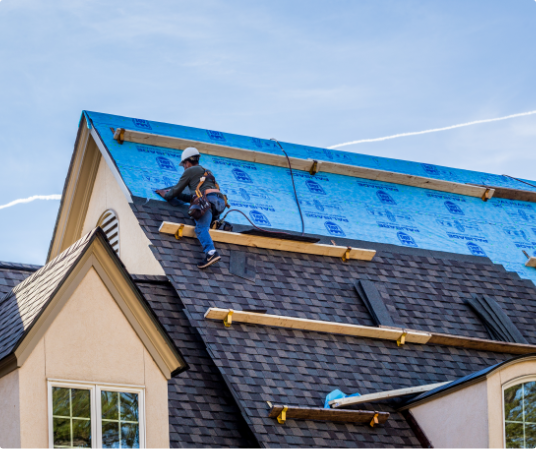Comparing Costs Amongst Roofing Companies in Gainesville Florida
Ideal Practices for Ensuring Proper Roofing Ventilation
A well balanced consumption and exhaust air vent ratio, generally 1:300, plays a critical role, with consumption vents preferably positioned at the lower side of the roofing for awesome air entry and exhaust vents at the top for cozy air departure. Maintaining insulation away from vents is crucial to protect against air flow limitation.
Understand Air Flow Essentials
Correctly understanding air flow essentials is important for making certain the long life and effectiveness of roof. Efficient ventilation mitigates dampness buildup and temperature level extremes in the attic room, both of which can bring about significant structural damage gradually. A well-ventilated roof covering helps in avoiding typical concerns such as mold growth, wood rot, and ice dams, which can compromise the honesty of the roofing products and the underlying structures.
The main objective of ventilation is to assist in the motion of air, allowing for a consistent exchange between the interior and outside atmospheres. This balance is accomplished through a combination of intake and exhaust vents that interact to maintain optimum airflow. Intake vents, commonly situated along the soffits or eaves, enable fresh air to enter the attic room, while exhaust vents, typically situated at or near the roofing ridge, allow warm, humid air to escape.
Secret elements affecting the performance of roof covering air flow consist of correct placement, ample sizing, and making certain that both intake and exhaust vents are unblocked. Routine examination and upkeep are important to identify potential blockages, damage, or ineffectiveness in the ventilation system, therefore safeguarding the roofing's performance and resilience.
Kinds Of Roof Covering Vents
Roof vents play an important duty in keeping efficient attic room ventilation and, by expansion, the general health and wellness of the roof. Various kinds of roof covering vents are available, each with unique benefits tailored to specific roof demands. Ridge vents, as an example, are mounted along the roof's top, allowing warm, moist air to escape from the attic room. They provide constant air flow and mix flawlessly with the roofline, making them both efficient and visually pleasing.

Soffit vents are mounted under the eaves and work in tandem with roofing vents to make certain a balanced intake and exhaust system. By allowing cooler air to go into from below, soffit vents promote the expulsion of hot air via upper vents. Gable vents, located on the exterior walls of the attic, deal an additional efficient option, particularly in homes with gable roofings.
Analyze Your Current Ventilation

Next, take into consideration the age and condition of your roofing materials and ventilation parts. Older systems may not adhere to his response current building ordinance or might have deteriorated in time, lowering their performance. Conduct an extensive assessment to determine any signs of damage, such as corrosion, damages, or spaces that can jeopardize the system's performance.
Furthermore, gauge the attic temperature and moisture levels. High temperatures and moisture can indicate insufficient ventilation.
Installment Best Practices
Efficient installment of roof covering air flow systems is paramount for guaranteeing optimum performance and longevity. Proper installation begins with comprehending the certain air flow demands of the structure and the roofing it covers. This entails computing the right ratio of intake to wear down vents, typically adhering to the 1:300 regulation, which specifies one square foot of air flow for each 300 square feet of attic floor space.

The positioning of vents is similarly important. Intake vents ought to be mounted at the roof covering's reduced edge, typically in the soffits, to allow amazing air to get in. Exhaust vents, on the various other hand, ought to be mounted near or at the roof covering's top to promote the exit of warm, wet air. This produces a natural airflow that helps preserve temperature and moisture balance within the attic room room.
Seal all vent connections meticulously to avoid air leaks and prospective water infiltration. Usage top notch products and comply with maker standards to ensure sturdiness and efficiency. Additionally, integrating ridge vents with baffles can significantly enhance air movement performance by preventing wind-driven rain and snow from going into the attic room.
Eventually, exact installation of roof air flow systems alleviates prospective issues such as mold development, ice dams, and structural damage, guaranteeing the roofing system's honesty and the building's overall wellness.
Regular Maintenance Tips
Consistency in maintenance methods is basic to making certain the long-lasting efficiency of roof covering air flow systems. Throughout these examinations, ensure that vents are free of particles, nests, and various other obstructions that could impede air flow.
Cleaning up the vents is an additional necessary task. Make use of a soft brush or a vacuum to get rid of dust and particles from consumption and exhaust vents. Beware not to damage the vent screens or louvers during the procedure. Furthermore, evaluate the attic room area for any indicators of water damage, which could endanger the honesty of the roof.
Appropriate insulation is equally important. Make sure that attic insulation does not obstruct the vents, as this can dig this drastically restrict air movement. If any kind of insulation has shifted or settled, rearrange or replace it to maintain a reliable obstacle.
Last but not least, replace any harmed or missing components immediately. Busted vents, cracked shingles, or scrubby blinking can all contribute to poor air flow and needs to be attended to immediately. Normal maintenance makes sure that the roof covering air flow system functions ideally, therefore prolonging the life-span of the roofing system itself.
Verdict
Ensuring correct roof ventilation is vital for keeping the performance and toughness of a roof. Adherence to the 1:300 consumption and exhaust vent proportion, coupled with the calculated placement of vents, is crucial. Routine semiannual assessments, debris cleansing, and making sure insulation does not obstruct air movement are crucial practices. Carrying out these best techniques will cultivate a well-ventilated roof, consequently minimizing possible concerns connected to moisture accumulation and extreme warm, eventually extending the roof covering's life expectancy.
A balanced intake and exhaust air vent ratio, generally 1:300, plays a critical duty, with consumption vents preferably positioned at the reduced edge of the roof covering for trendy air entrance and exhaust vents at the height for cozy air leave. Intake vents, normally situated along the soffits or official statement eaves, permit fresh air to get in the attic space, while exhaust vents, frequently situated at or near the roof covering ridge, make it possible for hot, damp air to run away.
Soffit vents are set up under the eaves and job in tandem with roof vents to make certain a balanced consumption and exhaust system. By allowing cooler air to get in from below, soffit vents promote the expulsion of warm air with upper vents. Adherence to the 1:300 consumption and exhaust air vent ratio, coupled with the tactical positioning of vents, is vital.